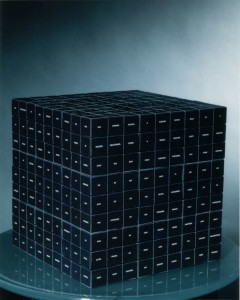Bibliomechanics is “bookish artware,” consisting of 27 Rubik’s cubes, stacked together into a block (3 x 3 x 3) so as to create the kind of pataphysical writing-machine described by Jonathan Swift in The Voyage to Laputa—”a project for improving speculative knowledge by […] mechanical operations” so that, by such a “contrivance[,] the most ignorant person […] may write books […] without the least assistance from genius or study.” Every facet of these cubes displays a white word printed in Futura on a black label so that, when properly stacked together, the cubes create 18 separate surfaces (6 exterior, 12 interior), each one of which becomes a page that displays a readable sentence (81 words long). Each sentence paraphrases a poetic theory about the machinic function of language itself. The reader can, of course, scramble each cube so as to create an alternative permutation, generating a new text from the vocabulary of the old text.
Bibliomechanics is a kind of 3D-version of Cents mille milliards de poèmes by Raymond Queneau, whose flipbook consists of 10 sonnets, in which corresponding lines can replace each other without altering the rhyme scheme or the lyric sense of any sonnet, thus permitting 10 trillion possible variants. An insomniac, reading one poem per second nonstop, requires about 317,000 years to complete such a work. A single Rubik’s cube, however, provides more than 4.3 x 1019 different permutations (albeit many nonsensical), and when we take into account all 27 cubes, this number increases by a factor of at least 27! x 627. An immortal, reading one page per second nonstop, might begin this book at the Big Bang, yet never hope to finish the text before the expiry of the universe itself. My book is perhaps more like a gizmo than a codex; however, the work does suggest that, no matter what its form, a book can still become a folding rhizome of unlimited dimension.
–Christian Bök
from BIBLIOMECHANICS
Top Facets
Front Facets

Bök’s permutations are fascinating. What we are building now — with our internetted networks of networks, our Matrix — is exactly his Rubik’s Cube, his “folding rhizome of unlimited dimension”.
The trick then is to “filter” all that — GoogleSearch does this best, currently, but just by skimming off the top of the heap of an enormous pile of retrievals, data-mined from a small part of a rapidly-increasing total — see Dark Web,
http://en.m.wikipedia.org/wiki/Dark_Internet
— and both retrieved and then ranked according to “relevance” — the joke on all of us being that “relevance” has been a nearly-total mystery to epistemology, one resolved ultimately by scepticism, cynicism, mysticism, but never science, since the Early Greeks, Persians, Chinese.
Only Hari Seldon offered us hope, perhaps: his universal laws never applied to the particular…
And Borges: in all his endless Library of Babel, “No hay, en la vasta biblioteca, dos libros idénticos”…
So bring on that Rubik’s Cube, Christian Bök, we’re ready for it… I hope…
So many possible permutations repels readers? and disallows the Text above as a statistical deviation just a rch left of Impossible–perhaps the awesome Bibliomechanics read its BooK into existence backwards from a future whose reader/mechanics have discovered a prototext that authorizes one divergence above all others, and does so out of love.